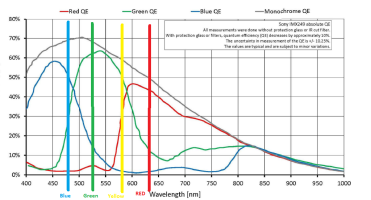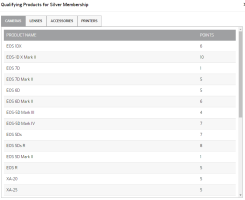For what reason specifically would you expect that to be the case with the high res R as well?
Frame rate and file sizes.
Upvote
0
For what reason specifically would you expect that to be the case with the high res R as well?
how do you suffer backfocus with a mirrorless, is that not a mirror issue?
I'm wondering as well, how can a focal plane-based focusing camera (that is, one that uses main sensor for focusing) front/back focus?
The camera has a feature where when you press the af-on button, when reviewing pictures, it zoomes in very close and exactly there, where the camera focused.What is your testing methodology?
I'm really glad that so many "pro" cameras and lenses will be released in the next few months but would like to know when we will have any new EF-S lenses and/or entrly level cameras with a bit improved performance. Let's say an 1200D Mark II with 18 MP sensor but all 9 cross-type and f/5.6 sensitive AF-points and Digic 6 processor.
I use the 5DSr for landscape, architecture, macro, focus-stacking, etc. Although 83mp would be interesting to work with, the file processing times would certainly be very long. I could imagine someone using such a high megapixel count for action and wildlife but I could never imagine how I would do that. It will be interesting to see what such a camera body looks like if it arrives. I would certainly consider something along those lines as a replacement for the 5DSr. The mirrorless system would work perfectly well for my purposes.
I’m very much waiting for the higher MP Eos R. For one project I have been shooting TS-E lenses on a 5Ds in low light. Getting pixel sharp with those lenses, in those conditions is a chore without an EVF.
For many 5D owners like me hoping to move to mirrorless, an 80mp camera is too much. So I hope you’re wrong on that and we get both
Regarding new DSLRs, all I know is that the 5DIV has seen some price drops consistent with being replaced in the next 12 months.
This is purely a marketing perception. My 5Ds has taken over everything...including sports, wildlife, and airshows...and the only thing I find wanting is the RAW buffer depth. It's even handling astro very well. I'm not sure why Canon pitched it as a 'narrow use' camera other than to preserve the higher USA price, or why so many reviewers presented it that way. There weren't any real differences (for stills) between it and the 5D3 except of course for that gorgeous sensor, and it handles every photographic situation well. Someone might point out file size or processing times, but you can always shoot in 28mp mraw.
Those looking for a true 5D4 equivalent mirrorless for stills will likely be satisfied by the high resolution R if they just use mraw when they don't want the full 83mp. The drawback will be the price, not a use or situation limiting spec.
Now for video I don't expect the high resolution R to be top of the line. It would be nice to be wrong here, but even the Sony A7r's have lower quality video than their 24mp brothers. It's just too much data to scale down at high quality. But for stills the 5Ds/sR are not actually narrow use cameras, and I don't expect the high resolution R to be either.
I don’t need the “pro” R body if that means a 1DX type. What I need is a 5D equivalent, with redundant card slots and at least 8fps. If an 80mp body is what canon chooses to release at this juncture in the schedule, I can only guess that they are consolidating the 5D and 5Ds equivalents into a single camera for the RF Mount. If that is true, then I really hope that they have a solution for those of us that don’t want or need 80mp. Say, 40 or 30mp M-RAW option would be perfect.
Added via a firmware update no less!
Jokes aside, a few ideas occur to me regarding OVF DPAF that I'm sure Canon engineers have considered at some point:
- Make use of main sensor DPAF "snapshots" during continuous shooting to augment discrete PDAF information
- Replace the PDAF and/or metering sensor with a, say, a few megapixel combined DPAF/metering sensor
- Rip out the discrete PDAF sensor and secondary mirror and use main sensor DPAF instead
Added via a firmware update no less!
Jokes aside, a few ideas occur to me regarding OVF DPAF that I'm sure Canon engineers have considered at some point:
- Make use of main sensor DPAF "snapshots" during continuous shooting to augment discrete PDAF information
- Replace the PDAF and/or metering sensor with a, say, a few megapixel combined DPAF/metering sensor
- Rip out the discrete PDAF sensor and secondary mirror and use main sensor DPAF instead
40 or 30mp M-RAW option would be perfect, provided there is no an IQ loss associated with shooting in M-RAW.
It’s not that big of a bump. The 5Ds and 5Dr were both 50.6 mp. That’s about the same % of a jump from 5d3 to 5d4.
I bet a 80 Mpix camera will have a 20 Mpix RAW mode where each image pixel has data from its own R, GG, B cells which might give you unprecedented IQ at medium high resolutions and that is one reason for such a camera.
In situations where resolution is required (with the right lens, tripod/enough light) you can do the "Bayer-trick" and you have 80 MPix.
Just with the 20 MPix mode file size would be 14+15+14 =43 bits per pixel resulting in 40...60 MByte files (with lossless compression). But this is half the file size and maybe 1/10th of the computing power (no debayering) so should be much faster compared to 80 MPix full res files.
20 MPix mode - Screen and small prints
80 MPix mode - large advertising posters, BIF for those who search the bird afterwards

70 135 f/2 would be very nice including 10 sessions in a fitness studio (2kg +)
I would be satisfied with a 100mm macro with f/2 resolving my dilemma with two lenses (2.8 macro + 2.0 100mm).
Add an RF 50 f/2 macro and this would maybe my preferred setup if I will ever switch to FF.
I don't understand why they don't care about the EF-M series, why they released m6 mk ii but let it limit with a row of shit lenses, I only use 32mm and 22mm, honestly I don't like using adapters
because it is not rugged enough to withstand a commercial use:
CPS membership is only available to professionals who own eligible EOS 1D, EOS 5D, L-series lens and Cinema EOS products (view eligible products).
there you have it.
I don't understand why the 7d2 is not considered 'professional' . So what if it has a crop sensor. Everything else about it is absolutely top shelf and it is a camera regularly used by professional photographers. Makes no sense really

